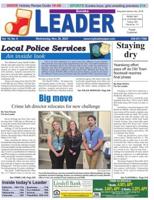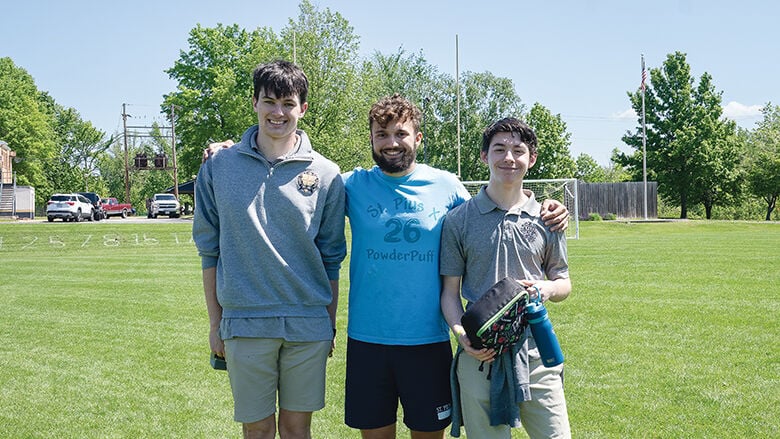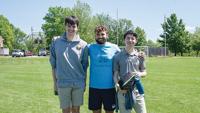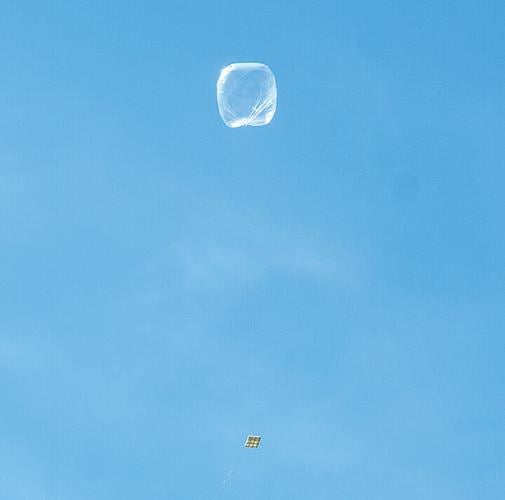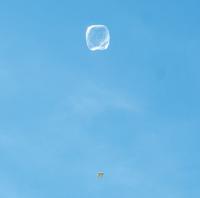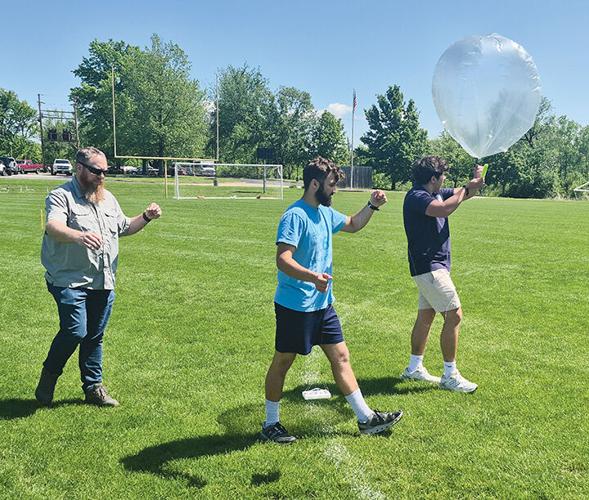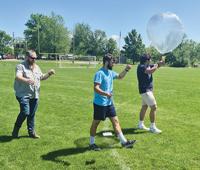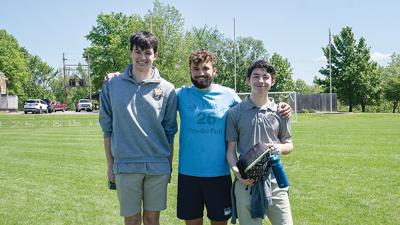On a clear day last week, members of the St. Pius X High School Amateur Radio Club watched their hard work float away.
Junior Alvaro Mejias, the club’s president, launched a pico balloon with a transmitter attached from the school’s football field on May 6 as approximately 30 students watched.
The balloon, made of Mylar and filled with hydrogen, was released into the sky with the expectation that students would track it on a website as it circled the earth at an altitude of about 40,000 feet.
“All of that hard work is gone in the wind,” said sophomore Kyle Hesse, a 17-year-old from the Fenton area who has been a member of the club since it formed in January 2024. “It is pretty cool that we got it to work.”

From left, Travis Few, a Midwest High-Altitude Balloon Team flight lead; Alvaro Mejias and Abram Brooks carry the St. Pius X High School Amateur Radio Club’s balloon on May 6 to its launch point on the school’s football field.
Mejias launched the balloon near the start of the school’s lunch period at 11 a.m. At about 11:50 a.m., it had already risen to about 14,000 feet.
Unfortunately, the balloon’s journey ended earlier than anticipated, coming down around sunset that day near Dawson Springs, Ky., after reaching a height of about 26,000 feet.
Pico balloons can circle the earth in about four to five days, and may remain in the air for more than a month, said Travis Few, a Midwest High-Altitude Balloon Team flight lead, who has helped the St. Pius club with the balloon project since late January.
“I figured out that I filled (the first balloon) up with too much hydrogen,” said Mejias, 17, of Oakville. “It popped at about half the height it was supposed to reach because I filled it up with about twice as much hydrogen as I was supposed to.
“We talked about (a possible second launch) earlier; let’s save the second balloon in case something goes wrong with the first balloon. It worked in our favor to have the second one on standby.”
The club, which is sponsored by the Jefferson County Amateur Radio Club, launched a second balloon on May 9.
Ray Benton, the vice president of the Jefferson County Amateur Radio Club, said that balloon reached a height of about 23,000 feet before coming down. The club believes it landed near the Mark Twain National Forest in southwest Missouri.
“We are looking at this as a learning experience,” said Benton, 71, of Festus. “I don’t think the kids are disappointed about it. As we are saying, it is like the Wright brothers. I don’t think their first flight went up, and if they did give up, where would we be?”
Benton said the club will likely try to launch a balloon again in August after school resumes. When balloons are launched, their flight may be tracked at amateur.sondehub.org by searching for the club’s call signal KF0QZK-11.

The balloon, tethered to a transmitter, rises into the sky.
Benton said even though the balloons didn’t travel as far as the club would have liked, he believes the launches created interest in the club.
“When school resumes in August, I think we are going to add to our numbers,” he said. “That was one of our goals, picking up more memberships in the club.”
The club
The balloon launch is one example of what the St. Pius Amateur Radio Club does when it meets each Monday during the school’s lunch period. It also illustrates how far the club has come after Mejias had a chance encounter with Benton.
Mejias said he got his radio license about two years ago, and he met Benton through amateur radio.
“I heard him (Mejias) calling out and asked where he was,” Benton said. “He said, ‘I’m over at St. Pius (in Crystal City).’ I asked if he was a student. He said, ‘Yes, I am at lunch.’ He then said, ‘I’m looking to start a radio club.’”
Benton, who was a band director at Windsor High School, said the meeting was serendipitous because he had wanted to start an amateur radio club at Windsor High, but he shifted his focus to St. Pius after connecting with Mejias, who also is a member of the Jefferson County Amateur Radio Club.
“They couldn’t have been more helpful,” Benton said of the St. Pius staff. “They gave us a place to meet and put our radios. This is unique. You won’t find many clubs like this. There used to be amateur radio clubs in the high schools, but we can’t find another one in the greater St. Louis area.”
St. Pius Principal Karen DeCosty said she was happy to give Mejias and Benton the green light to start the club, and custodian Robert Kausler, who has an amateur radio license, has assisted the club by installing antennas and running cable.
“The amateur radio club is an example of how one student can turn his or her interest into something that other students may want to explore and learn about,” she said. “Clubs give students opportunities to learn more about a variety of things and forge lasting friendships. We encourage all students to find something they are passionate about and share it with the rest of the school.”
Benton said the Jefferson County club donated two radios and other equipment, altogether worth about $2,000, to the St. Pius club, and it provided a $500 grant for the balloon project.
“They always ask us what they can do to help,” Mejias said of the Jefferson County Amateur Radio Club. “Their club has been really excited because most amateur radio operators are over 60 years old. They get really excited when there are young people. When there are five people in a high school meeting every Monday, it is like a dream come true for them.”
Learning
Mejias said the club members usually spend the first 10 to 15 minutes of their approximately hourlong lunch period going over basics of amateur radio, discussing different frequencies, modes, radios and antennas that are used. Then the club members spend about 30 minutes using the radios to try to contact other radio users.
Benton said the club has VHF radio that can contact other radios within about a 50-mile radius and an HF radio that can contact radios around the world.
“We want members to learn the basics and get comfortable talking over the air,” Mejias said.
Sophomore Lucas Powell, 16, of Cedar Hill said he joined the club in March because he is interested in how radios work. He also is a volunteer with the Cedar Hill Fire Protection District and uses a radio to communicate with other firefighters.
“I’ve learned a lot about AM and FM frequencies,” he said. “I’ve learned that you can be nervous to talk on the radio. It can be difficult to do.”
Mejias said amateur radio has allowed him to explore his interest in electronic engineering.
“You start making connections and dive into topics to see what you really like about amateur radio,” he said. “That can turn into where you may want to go for college, and what you may want to do in the future.”
Benton said it is exciting to see how much fun the students have as they contact other radio users. Club members have talked to people in Alaska, West Virginia and North Carolina.
“There was one student who had been trying to make a contact. He tried three times and didn’t get one,” Benton said. “Finally, someone from North Carolina responded. (The St. Pius student) was so excited that he jumped into the air, and when he came down, he fell on the chair and ended up on the floor.
“When we got done that day, the kids said, ‘Do we have to go to class? Can’t we just sit in here and make more contacts?’ That was an epic day for me because it was young people excited about using radio.”
